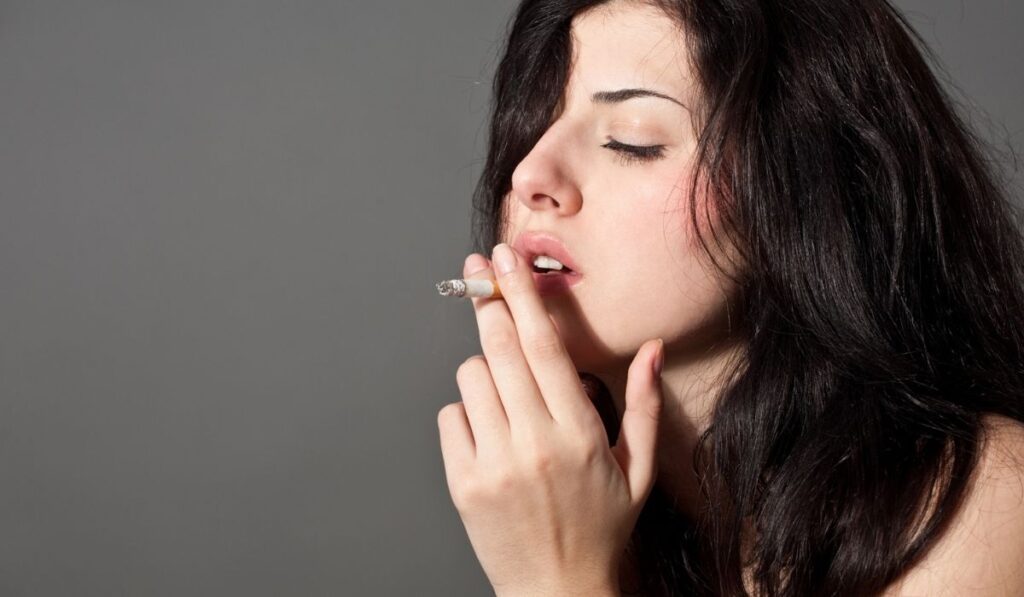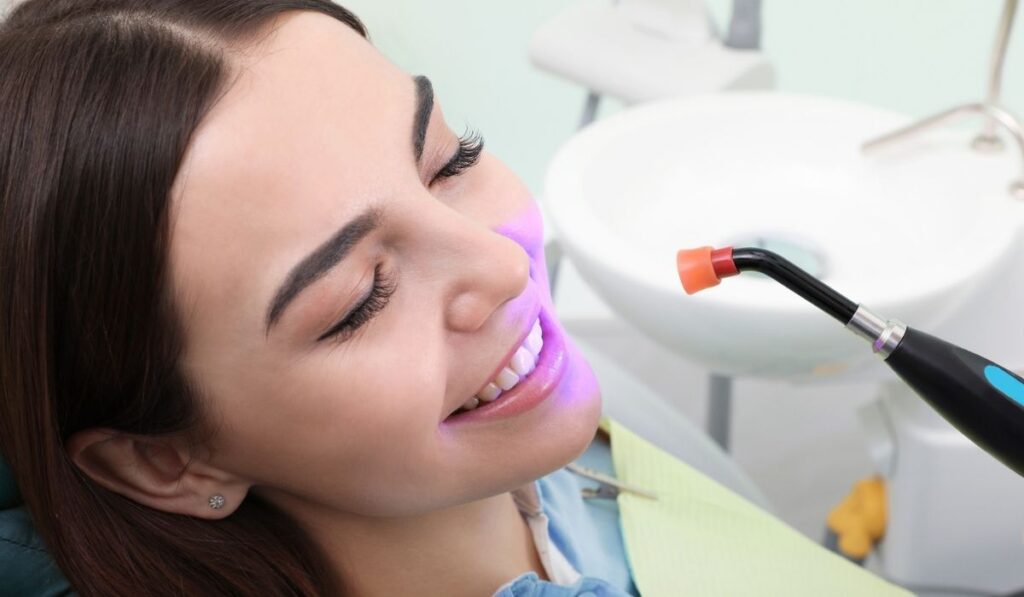We’re all pretty familiar with the dangers of smoking cigarettes and tobacco. But not everyone knows about the effects smoking can have on the teeth. So, if you’re a regular smoker, how can you limit the staining that occurs on on your pearly whites?
Proper oral hygiene techniques, specialty products, and natural remedies can help reduce tooth discoloration from smoking. You can rinse with hydrogen peroxide, use anti-tar mouthwash, and even eat more fruits to help fight stains. Consult your dentist to determine the best steps.
Don’t panic if you’ve noticed a few tobacco stains — there are several steps you can take to reduce and prevent further damage to your teeth. Here’s everything you need to know about fighting tobacco stains from smoking.
How Does Smoking Damage Your Teeth?

Smoking damages your teeth in a number of ways. Smoking tobacco can lead to stains, dental decay, gum disease, bad breath, and other adverse health complications over time.
Tobacco contains nicotine, a chemical substance that turns brown as soon as it reaches oxygen. The porous consistency of tooth enamel easily absorbs nicotine particles, causing discoloration in the process. The stains from tobaccos aren’t uniform and are usually on the edges of the teeth, near the gums.
Smoking doesn’t directly cause dental decay. However, it negatively impacts the mouth’s natural defense mechanisms, making it increasingly difficult to maintain adequate oral health.
Nicotine can reduce the flow of saliva and cause the mouth to become dry. This creates weak saliva that isn’t strong enough to protect the teeth, resulting in greater chances for tooth decay and gum disease.
Smokers are more likely to lose teeth compared to non-smokers. This increased risk is due to higher levels of gum disease and lower levels of oxygen in the blood. Lower levels of oxygen make it more difficult for the gums to heal themselves over time.
Finally, smokers have a much greater risk of developing oral cancers, including of the throat, lips, and tongue. In fact, smokers might have six times the chance of developing one of these cancers compared to non-smokers.
How to Keep Your Teeth White While Smoking
There are a few methods you can use to avoid and prevent discoloration while smoking. Follow the methods below to help keep your teeth as white as possible.
Brush Daily
As we mentioned above, smokers tend to have poorer oral health conditions and a greater risk of periodontal disease compared to non-smokers. That’s why it’s crucial for smokers to brush daily and practice good oral hygiene techniques.
Be sure to brush at least twice daily and up to three times. Use a soft-bristled toothbrush, like the Colgate 360 (on Amazon), and brush for around 2 minutes during each session.
Use Special Toothpaste
You can also consider using special toothpaste brands designed for smokers like this one (on Amazon). These kinds of toothpaste have more abrasive components, such as baking soda or alumina.
The abrasive ingredients can help remove tar, nicotine, and discoloration. However, they can damage and weaken tooth enamel over time. Be sure to consult your dentist beforehand.
Use Special Mouthwash
Smokers can also use specially-designed anti-tar mouthwashes that are used to reduce the amount of tar and chemicals from smoking. Normal mouthwash products won’t whiten teeth but might improve oral health.
Options like the TheraBreath oral rinse (on Amazon) will always be focused on breath first, and whitening teeth second, so brushing is much more important than this step for managing teeth color.
Be sure to look for brands that are designed to fight gingivitis and the negative effects of smoking. As always, consult your dentist beforehand to determine which products are right for you and your circumstances.
Don’t Forget to Floss!
Daily flossing is often overlooked by smokers and non-smokers alike. However, daily flossing can help remove plaque, tar, and nicotine buildup. This can help reduce and prevent stains or discoloration.
Be sure to floss at least twice daily or after each meal. The type of floss isn’t as important as adding it to your daily routine is. Tools like this reusable dental floss holder (on Amazon) can make the process simpler and easier…meaning you’re more likely to do it regularly!
Schedule Regular Checkups
Finally, you should schedule regular checkups with your dentist if you’re a smoker. You might even want to schedule more frequent appointments than a non-smoker would. The dentist will give your teeth a deep cleaning, removing any plaque, nicotine, or tar buildup in the process.
The dentist will also determine if you have symptoms of gum disease. Be sure to consult with your primary dentist to determine how often you should come in for a checkup or deep cleaning.
How to Remove Tobacco Stains on Your Teeth

Don’t worry too much if you notice some stains or discoloration from smoking. There are a few methods you can employ to start removing tobacco stains from your teeth.
Use Whitening Toothpaste
Using whitening kinds of toothpaste is one of the ways you can start to remove tobacco stains. Look for products that are designed to whiten teeth, such as REMBRANDT’s Whitening Toothpaste With Fluoride (on Amazon).
These products can help remove surface stains caused by smoking. However, whitening toothpaste might lead to increased sensitivity, so be sure to consult your dentist beforehand.
Consider Whitening Strips
Whitening strips and similar products are another option for reducing discoloration from smoking tobacco. You can purchase these products over the counter from your local drugstore.
Some products dissolve over time, while others require you to leave them in your mouth for a certain timeframe. Be sure to follow all the package instructions and consult your dentist beforehand.
Rinse With Hydrogen Peroxide
You can also use hydrogen peroxide solutions to help whiten your teeth. Dilute less than an ounce of hydrogen peroxide (on Amazon) with water and use the solution to rinse out your mouth. Swish the solution for around 30 seconds, spit it out, and rinse thoroughly with water. Remember that this is a home remedy, and your mileage will vary.
Change Your Diet
Changing your diet is another natural remedy for fighting tooth stains and discoloration. Apples, carrots, and celery can help fight tooth stains. These foods improve saliva production and are chock full of Vitamin C. Both of these components can help prevent periodontal disease and gingivitis and keep your mouth healthy.
Citrus fruits like oranges and pineapples can also increase saliva production. Lemons can be advantageous for teeth whitening. In fact, adding lemon juice to a bit of water can brighten your smile. Just be sure not to go overboard, as the acidity can damage tooth enamel over time.
Laser Whitening Treatment
Laser teeth whitening treatments are another option for removing nicotine and tobacco stains. This treatment is completed in a professional dentist’s office.
The dentist typically paints your teeth with a peroxide solution and uses an incredibly strong laser to remove stains. The timeframe can vary, but the procedure typically takes anywhere from 15 to 60 minutes.
Chemical Whitening Treatments
Chemical whitening treatments are another professional option for removing stains and discoloration. Typically, the dentist will use a bleaching agent to whiten your teeth.
In some cases, you might use an at-home mouth tray over the course of a few days to weeks. The treatment is typically painless but comes with some risks.
Chemical whitening treatments can increase sensitivity and weaken the teeth in some cases. Be sure to consult your dentist to determine whether you qualify for this treatment and if it’s right for you.
Veneers
Veneers are another option. Veneers are made of the porcelain laminate and cover the teeth. These products are used to create the appearance of bright, white, and healthy teeth.
Your dentist will remove a bit of tooth enamel and apply a layer of adhesive to the veneers. Veneers are some of the most effective ways to create a new smile. They’re also stain-resistant!
However, not everyone meets the requirements for veneers, and they can be quite expensive. Be sure to consult your dentist to determine whether this type of treatment is right for you and your circumstances.
The Root of the Problem
Now you know some great ways to prevent and treat the stains that occur from smoking. But at the end of the day, the best solution to this type of staining is, of course, to limit and ultimately stop smoking.
No matter how much work you put into preventing stains, it’ll be difficult to keep your teeth and overall oral health in tip-top shape as long as you continue smoking.


